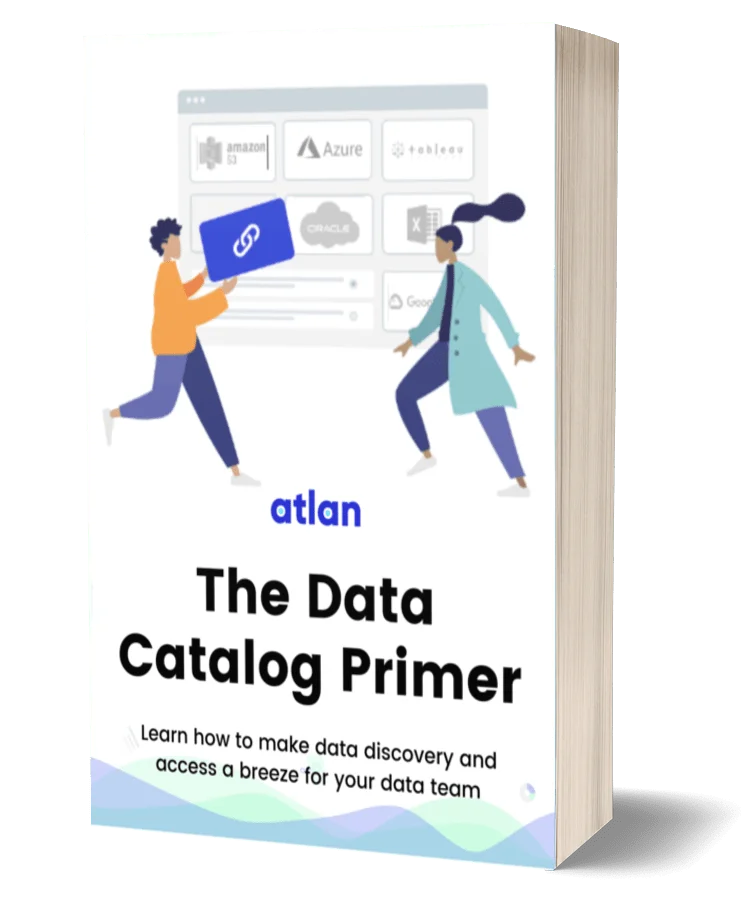Data Fabric Architecture Explained: Framework, Tools, and Examples

Share this article
Data fabric architecture connects data across distributed environments, enabling seamless data access and sharing. It integrates various data sources, platforms, and storage systems, using AI and machine learning to automate data management, enhance data governance, and provide a unified view. This architecture optimizes data usage for analytics and real-time insights across enterprises.
See How Atlan Simplifies Data Governance – Start Product Tour
Data fabric architecture is a distributed data management framework that enables access, integration, and processing of data across multiple sources and formats.
The data fabric is a technology-agnostic architecture pattern that contains several components, such as data ingestion, storage, processing etc. It is a design concept that serves as an integrated layer (fabric) of data and connecting processes.
In this article, we will explore the various components of the data fabric architecture and understand how to deploy it.
Let’s begin!
Table of contents #
- What is data fabric architecture?
- Example
- Key components
- What is a data fabric architecture framework?
- Tools
- Best practices
- Atlan for Data Security & Compliance
- To summarize
- FAQs on data fabric architecture
- Related reads
What is data fabric architecture? #
Data fabric architecture is a modern data management framework designed to address the challenges of handling and leveraging data in a complex, distributed, and hybrid computing environment. It is a holistic approach that enables organizations to seamlessly manage, access, and utilize data across a variety of data sources, locations, and formats.
The concept of a data fabric is particularly relevant in today’s data-driven world, where data is generated at an unprecedented pace and is often spread across on-premises, cloud, and edge environments.
Characteristics of data fabric architecture #
The following are the key characteristics of a data fabric architecture:
- Unified data access
- Data integration and orchestration
- Scalability and flexibility
- Data governance and security
- Real-time data insights
- Hybrid and multi-cloud support
- Metadata management
Let’s look at them in detail:
- Unified data access
Data fabric provides a unified and consistent way to access data, regardless of where it resides. It abstracts the underlying complexity of data sources, making it easier for organizations to extract insights from their data, regardless of whether it’s stored in databases, data lakes, SaaS applications, or other repositories.
- Data integration and orchestration
Data fabric architecture includes data integration and orchestration capabilities that enable data to flow seamlessly between different systems and locations. This ensures that data can be moved, transformed, and synchronized as needed to support various business processes and analytics.
- Scalability and flexibility
Data fabric is designed to scale horizontally, allowing organizations to handle growing data volumes and workloads. It is flexible and adaptable to accommodate changes in data sources, processing requirements, and infrastructure configurations.
- Data governance and security
Data fabric emphasizes robust data governance and security controls. It enables organizations to define and enforce data access policies, monitor data usage, and ensure compliance with data privacy regulations. This is critical for maintaining data integrity and protecting sensitive information.
- Real-time data insights
Data fabric supports real-time data streaming and processing, enabling organizations to gain insights from data as it is generated or ingested. This is particularly valuable for applications that require immediate decision-making based on up-to-the-minute information.
- Hybrid and multi-cloud support
Many organizations operate in hybrid or multi-cloud environments, and data fabric architecture is well-suited to managing data across these diverse infrastructures. It allows data to flow seamlessly between on-premises data centers, public cloud platforms, and edge devices.
- Metadata management
Metadata plays a crucial role in data fabric architecture. It helps organizations catalog and describe their data assets, making it easier to discover and understand the available data resources. Effective metadata management is essential for data governance and data lineage tracking.
In summary, data fabric architecture is a comprehensive approach to managing and harnessing data in today’s complex IT landscape. It provides organizations with the agility, scalability, and control needed to leverage data as a strategic asset. By unifying data access, integrating diverse data sources, and ensuring governance and security, data fabric architecture helps organizations extract actionable insights and drive innovation from their data resources.
What is an example of data fabric architecture? #
Before we move ahead, let us quickly look at how the data fabric architecture is used in modern data-driven organizations.
One real-life example of data fabric architecture is the implementation of a unified data platform in a large healthcare organization. The data fabric integrates various data sources, such as electronic health records, medical imaging, and patient monitoring systems, into a single virtual layer.
This allows healthcare professionals to access and analyze patient data in a cohesive and efficient manner, improving patient care and decision-making processes.
Read our detailed blog for more in-depth examples and use cases of data fabric architecture.
10 Key components of data fabric architecture to consider for your organization #
A data fabric is a composable, flexible and scalable way to maximize the value of data in an organization. The architecture should offer a single virtual layer to manage all data assets and leverage automation to optimize data management.
Here are some key components of data fabric architecture that you should consider:
- Data ingestion
- Data storage
- Data processing
- Data catalog and metadata management
- Data governance and security
- Data integration and transformation
- Data analytics and visualization
- Data orchestration and workflow management
- Decoupled architecture
- Monitoring and logging
Let’s explore each component of the data fabric architecture further:
1. Data ingestion #
The data fabric should be able to ingest data from various sources, such as transactional databases, third-party APIs, log files, and streaming data.
So, choose a data fabric architecture that allows for seamless integration and supports a wide range of data formats — structured, semi-structured, and unstructured data.
2. Data storage #
A data fabric solution should have a distributed and scalable storage layer, capable of handling large volumes of data.
Consider using cloud-based storage solutions like Amazon S3, Google Cloud Storage, or Azure Blob Storage as they provide high durability, availability, and scalability.
3. Data processing #
Data fabric should support both batch and real-time data processing to handle different types of workloads.
Leverage technologies like Apache Spark, Apache Flink, or Apache Beam for processing large volumes of data efficiently.
4. Data catalog and metadata management #
A data catalog is essential for discovering, understanding, and managing the metadata associated with the data assets.
Implement a comprehensive data catalog to maintain information about data sources, schema, data lineage, and data quality that make up your data fabric.
Read more → 5 essential features to consider in data catalogs for the data fabric
5. Data governance and security #
Ensure data privacy and compliance by implementing robust data governance policies and security measures, such as data masking, encryption, and access control mechanisms.
Having a single virtualization layer to govern your data assets cuts down the complexities in data governance and security.
6. Data integration and transformation #
The data fabric should facilitate data integration and transformation processes, like data cleansing, enrichment, and aggregation. You can use tools like Apache NiFi for these tasks.
7. Data analytics and visualization #
Enable users to access, analyze, and visualize data through self-service analytics tools, such as Tableau, Power BI, or Looker. Ensure that these tools are integrated with the data fabric to provide a seamless experience.
8. Data orchestration and workflow management #
Incorporate data orchestration and workflow management tools like Apache Airflow, Prefect, or Luigi to automate and monitor data pipelines.
9. Decoupled architecture #
A data fabric should be modular and decoupled to support flexibility, scalability, and maintainability. Use microservices and containerization technologies like Docker and Kubernetes for better resource management and deployment.
10. Monitoring and logging #
Implement robust monitoring and logging mechanisms to track system performance, identify bottlenecks, and ensure data quality.
By considering these aspects of the data fabric architecture, you can build a robust, scalable, and secure data platform that empowers your e-commerce company to continue its rapid growth while maintaining data-driven decision-making capabilities across all teams.
Also read → Can the data fabric future-proof your architecture, unify your data, and save costs?
Now that you know of the various components making up your data fabric, the next step is to find out the right tools for each component.
So, what is a data fabric architecture framework? #
The data fabric architecture framework is a structured approach to designing, implementing, and managing a data fabric within an organization. This framework aims to standardize and streamline the process of integrating various data components and platforms, ensuring that they work cohesively.
The key components of the data fabric architecture framework are:
- Unified data access
- Data integration and orchestration
- Metadata management
- Data governance and quality
- Data security and privacy
- Data processing and analytics
- Infrastructure and storage management
- Service orchestration
- User interfaces and APIs
Now, let’s elaborate on each of these components:
1. Unified data access #
This component ensures that data, regardless of its source or location, can be accessed seamlessly. It simplifies the process of retrieving data from various systems, databases, or cloud environments. Unified data access reduces the challenges users face due to data silos and promotes a consistent data access experience.
2. Data integration and orchestration #
This aspect of the framework focuses on how data from different sources can be brought together, integrated, and made to interact harmoniously. Orchestration refers to the automated arrangement, coordination, and management of these complex data integrations. This ensures that data flow and processes are smooth and efficient.
3. Metadata management #
Metadata, often referred to as “data about data,” provides context and additional information about primary data. Effective metadata management helps users understand, discover, and manage data better. This component is vital for tasks like data cataloging, lineage tracking, and ensuring data transparency.
4. Data governance and quality #
This part of the framework addresses the rules, policies, standards, and procedures associated with data. Data governance ensures that data is accurate, reliable, and used appropriately. Simultaneously, data quality mechanisms are put in place to maintain the integrity and quality of the data, ensuring it’s fit for its intended use.
5. Data security and privacy #
In the modern data landscape, security and privacy are paramount. This component deals with the mechanisms and practices that protect data from breaches, unauthorized access, and leaks. It also ensures compliance with various regulations, such as GDPR or CCPA.
6. Data processing and analytics #
After data is ingested and integrated, it often needs to be processed, transformed, or analyzed. This segment ensures that the framework can support both real-time and batch processing. It also provides tools for analytics, machine learning, and other advanced data operations.
7. Infrastructure and storage management #
This is about how data is stored, retrieved, and managed at the infrastructure level. It encompasses considerations for database management, storage optimizations, and ensuring data persistence and durability.
8. Service orchestration #
As the data fabric might include various services, such as data lakes, warehouses, ETL tools, and more, service orchestration ensures that these services work in a coordinated manner. It is about the efficient management of these services to ensure optimal performance and resource utilization.
9. User interfaces and APIs #
For a data fabric to be truly effective, it needs to be user-friendly. This component ensures that the right interfaces, dashboards, and APIs are available for different users, be it data engineers, data scientists, analysts, or business users.
The data fabric architecture framework enables businesses to have a clear roadmap for handling their data operations, from ingestion and integration to processing and governance.
It helps organizations to ensure they’re taking a holistic and standardized approach to data management. This not only boosts efficiency and agility but also ensures that data remains a consistent, trustworthy, and valuable asset.
Tools used to make up the various components of data fabric architecture #
Here is a list of open source and enterprise tools that can be used to compose various components of the data fabric architecture:
- Data ingestion tools
- Data storage tools
- Data processing tools
- Data catalog and metadata management tools
- Data governance and security tools
- Data integration and transformation tools
- Data analytics and visualization tools
- Data orchestration and workflow management tools
- Decoupled architecture tools
- Monitoring and logging tools
Let’s explore the various tools of data fabric architecture in detail.
1. Data ingestion tools #
- Open Source: Apache NiFi, Logstash, Fluentd, Telegraf
- Enterprise: StreamSets, Confluent Kafka
2. Data storage tools #
- Open Source: Apache Hadoop HDFS, MinIO, Ceph, PostgreSQL, Apache Cassandra
- Enterprise: Amazon S3, Google Cloud Storage, Azure Blob Storage, Snowflake, Databricks Delta Lake
3. Data processing tools #
- Open Source: Apache Spark, Apache Flink, Apache Beam, Apache Hadoop MapReduce
- Enterprise: Google Dataflow, Amazon Kinesis Data Analytics, Azure Stream Analytics, Databricks
4. Data catalog and metadata management tools #
- Open Source: Amundsen, DataHub, Apache Atlas
- Enterprise: Atlan , AWS Glue Data Catalog, Google Cloud Data Catalog
5. Data governance and security tools #
- Open Source: Apache Ranger, Apache Knox
- Enterprise: Okera, Immuta, Privacera, Amazon Macie, Google Cloud Data Loss Prevention
6. Data integration and transformation tools #
- Open Source: Apache NiFi, Talend Open Studio, Singer
- Enterprise: Informatica PowerCenter, Microsoft SQL Server Integration Services, IBM InfoSphere DataStage
7. Data analytics and visualization tools #
- Open Source: Apache Superset, Metabase, Redash
- Enterprise: Tableau, Power BI, Looker, QlikView
8. Data orchestration and workflow management tools #
- Open Source: Apache Airflow, Prefect, Luigi
- Enterprise: Google Cloud Composer, Amazon Managed Workflows for Apache Airflow, Azure Data Factory
9. Decoupled architecture tools #
- Open Source: Docker, Kubernetes, Helm, Istio
- Enterprise: Amazon ECS, Google Kubernetes Engine, Azure Kubernetes Service, Red Hat OpenShift
10. Monitoring and logging tools #
- Open Source: Prometheus, Grafana, ELK Stack (Elasticsearch, Logstash, Kibana), Jaeger, Zipkin
- Enterprise: Datadog, Splunk, New Relic, Amazon CloudWatch, Google Stackdriver
Each of the tools listed above can be combined to create a comprehensive data fabric architecture that meets your organization’s needs in terms of scalability, flexibility, and maintenance.
11 best practices to follow for a successful deployment of the data fabric architecture #
Deploying a data fabric architecture is a complex task that requires careful planning and execution. Here are some key aspects to keep in mind during the deployment process:
- Assess existing systems 👉 Understand the current data landscape, including data sources, storage systems, processing engines, and analytics tools. Identify areas of improvement, bottlenecks, and any potential limitations of your current infrastructure.
- Define clear objectives and requirements 👉 Collaborate with stakeholders to define the business objectives, performance requirements, and specific use cases that the data fabric architecture should address.
- Plan for scalability and flexibility 👉 Choose components and design patterns that can scale horizontally to accommodate the growth of data volume, variety, and velocity. Ensure that the architecture is modular and can evolve over time to incorporate new technologies and changing business needs
- Security and compliance 👉 Incorporate data governance, security, and compliance best practices from the beginning. Consider data encryption, access control, data masking, and auditing to protect sensitive information and comply with relevant regulations.
- Data quality and consistency 👉 Implement data quality checks, validation rules, and monitoring mechanisms to ensure data consistency and accuracy across the entire data fabric.
- Integration and interoperability 👉 Ensure that the chosen tools and components integrate well with each other and can interoperate with existing systems. This may involve data format conversions, data transformation, and data synchronization.
- Resource allocation and cost optimization 👉 Plan for efficient resource allocation, taking into consideration data storage, processing, and transfer costs. Utilize cloud services’ pricing models and autoscaling capabilities to optimize costs
- Deployment strategy 👉 Decide whether to deploy the data fabric architecture on-premises, in a public cloud, or in a hybrid environment. Consider factors such as data gravity, latency, and security when making this decision.
- Change management 👉 Introduce the new data fabric architecture in a phased manner, and provide training and support to help users adapt to the new system. Communicate the benefits of the data fabric to stakeholders and demonstrate its impact on business outcomes
- Monitoring, logging, and observability 👉 Implement comprehensive monitoring and logging solutions to track system performance, identify bottlenecks, and troubleshoot issues. Ensure that the system is observable and can provide insights into its internal workings.
- Documentation and knowledge sharing 👉 Document the data fabric architecture, including its components, data flow, data lineage, and data catalog. Encourage knowledge sharing and collaboration among the teams involved in building, maintaining, and using the data fabric.
By keeping these factors in mind during the deployment process, you can create a robust, secure, and scalable data fabric architecture that empowers your organization to derive valuable insights from its data assets.
Atlan for Data Security & Compliance #
Atlan helps customers ensure data security and compliance when using semi-structured data with features that include:
- Automated data classification
- Access control features like Role-Based Access Control
- Masking policies
- Bi-directional tag syncing
These features work together to protect sensitive data, automate compliance tasks, and provide visibility into data access and usage.
Also, Atlan can help to improve data security and compliance by providing visibility into data lineage, including across different systems and environments. By understanding the flow of data, organizations can more easily identify and mitigate potential risks.
Legendary Consumer Brand Dr. Martens Improves Data Discoverability, Impact Analysis, and Business Collaboration on Data With Atlan.
At a Glance #
- Dr. Martens, an iconic global footwear brand with a six-decade heritage, evaluated the data catalog space in order to drive self-service atop their quickly modernizing data stack.
- Choosing Atlan, their data team quickly implemented a self-service catalog to provide context around their most critical data assets.
- Atlan’s implementation has accelerated time-to-insight for Dr. Martens’ internal data consumers, and is reducing time spent on impact analysis from four to six weeks, to under 30 minutes for data practitioners.
Book your personalized demo today to find out how Atlan can help your organization in ensuring data security and compliance.
To summarize #
We’ve discussed the concept of a data fabric architecture and its key components.
We explored various open-source and enterprise tools that can be used to build different components of the data fabric. These tools enable organizations to create a comprehensive and robust data platform that meets their specific needs.
Lastly, we covered important considerations for deploying a data fabric architecture.
By understanding these concepts and taking these factors into account, you can successfully implement a data fabric architecture that supports data-driven decision-making.
FAQs on data fabric architecture #
1. What is data fabric architecture, and how does it work? #
Data fabric architecture is a distributed data management framework that enables seamless access, integration, and processing of data across diverse sources and formats. By acting as an integrated layer, it connects various data processes, allowing organizations to efficiently manage and utilize data, regardless of location or format.
2. How does data fabric architecture improve data integration? #
Data fabric architecture enhances data integration by creating a unified platform that facilitates real-time data access from multiple sources. This approach simplifies the integration of structured and unstructured data, ensuring that data from various sources is harmonized and ready for analysis and insights.
3. What are the benefits of implementing data fabric architecture? #
Implementing data fabric architecture provides numerous benefits, including improved data accessibility, enhanced governance, and seamless integration across data silos. It helps organizations make data-driven decisions more effectively, enabling better insights, compliance, and operational efficiency.
4. How is data fabric architecture different from data mesh or traditional data warehousing? #
Data fabric architecture differs from data mesh and traditional data warehousing in its approach to data integration and management. Unlike data warehousing, which centralizes data storage, data fabric architecture decentralizes access while maintaining an interconnected layer. Data mesh focuses on domain-oriented ownership, whereas data fabric emphasizes a unified access layer across all data.
5. What are the key components of a data fabric architecture? #
Key components of data fabric architecture include data ingestion, data storage, data processing, data governance, and data security. These elements work together to create an integrated data framework that provides seamless access, management, and governance across data sources.
6. How can data fabric architecture enhance data governance? #
Data fabric architecture enhances data governance by centralizing policies, ensuring compliance, and maintaining data quality across diverse data sources. It provides a unified governance layer that enables organizations to monitor, audit, and control data usage, ensuring secure and compliant data access.
Data fabric architecture: Related reads #
- Data Fabric: Can it Future-Proof Your Architecture, Unify Your Data, and Save Costs?
- What is Data Fabric: Definition, Components, Benefits & Use Cases
- Data Mesh vs. Data Fabric: How do you choose the best approach for your business needs?
- Data Catalog for Data Fabric: 5 Essential Features to Consider
- Data Fabric vs. Data Virtualization: Overview, Comparison, and Differences
- Data Fabric vs. Data Lake: What’s Right for You and When?
- Data Catalog: What It Is & How It Drives Business Value
- What Is a Metadata Catalog? - Basics & Use Cases
- Modern Data Catalog: What They Are, How They’ve Changed, Where They’re Going
- Open Source Data Catalog - List of 6 Popular Tools to Consider in 2024
- 5 Main Benefits of Data Catalog & Why Do You Need It?
- Enterprise Data Catalogs: Attributes, Capabilities, Use Cases & Business Value
- The Top 11 Data Catalog Use Cases with Examples
- 15 Essential Features of Data Catalogs To Look For in 2024
- Data Catalog vs. Data Warehouse: Differences, and How They Work Together?
- Snowflake Data Catalog: Importance, Benefits, Native Capabilities & Evaluation Guide
- Data Catalog vs. Data Lineage: Differences, Use Cases, and Evolution of Available Solutions
- Data Catalogs in 2024: Features, Business Value, Use Cases
- AI Data Catalog: Exploring the Possibilities That Artificial Intelligence Brings to Your Metadata Applications & Data Interactions
- Amundsen Data Catalog: Understanding Architecture, Features, Ways to Install & More
- Machine Learning Data Catalog: Evolution, Benefits, Business Impacts and Use Cases in 2024
- 7 Data Catalog Capabilities That Can Unlock Business Value for Modern Enterprises
- Data Catalog Architecture: Insights into Key Components, Integrations, and Open Source Examples
- Data Catalog Market: Current State and Top Trends in 2024
- Build vs. Buy Data Catalog: What Should Factor Into Your Decision Making?
- How to Set Up a Data Catalog for Snowflake? (2024 Guide)
- Data Catalog Pricing: Understanding What You’re Paying For
- Data Catalog Comparison: 6 Fundamental Factors to Consider
- Alation Data Catalog: Is it Right for Your Modern Business Needs?
- Collibra Data Catalog: Is It a Viable Option for Businesses Navigating the Evolving Data Landscape?
- Informatica Data Catalog Pricing: Estimate the Total Cost of Ownership
- Informatica Data Catalog Alternatives? 6 Reasons Why Top Data Teams Prefer Atlan
- Data Catalog Implementation Plan: 10 Steps to Follow, Common Roadblocks & Solutions
- Data Catalog Demo 101: What to Expect, Questions to Ask, and More
- Data Mesh Catalog: Manage Federated Domains, Curate Data Products, and Unlock Your Data Mesh
- Best Data Catalog: How to Find a Tool That Grows With Your Business
- How to Build a Data Catalog: An 8-Step Guide to Get You Started
- The Forrester Wave™: Enterprise Data Catalogs, Q3 2024 | Available Now
- How to Pick the Best Enterprise Data Catalog? Experts Recommend These 11 Key Criteria for Your Evaluation Checklist
- Collibra Pricing: Will It Deliver a Return on Investment?
- Data Lineage Tools: Critical Features, Use Cases & Innovations
- OpenMetadata vs. DataHub: Compare Architecture, Capabilities, Integrations & More
- Automated Data Catalog: What Is It and How Does It Simplify Metadata Management, Data Lineage, Governance, and More
- Data Mesh Setup and Implementation - An Ultimate Guide
- What is Active Metadata? Your 101 Guide
Share this article










